1 of 34
Downloaded 26 times

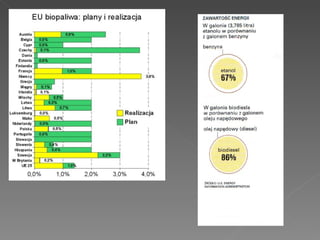


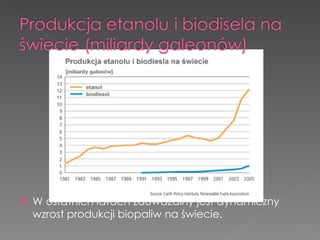


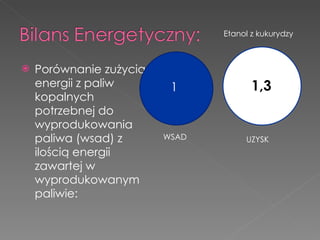
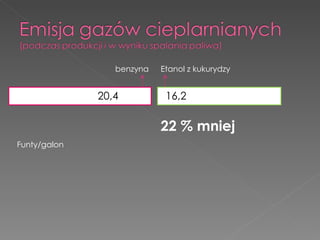
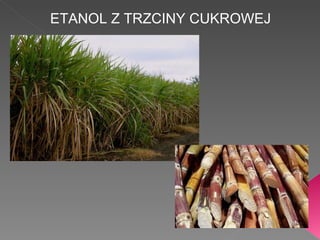

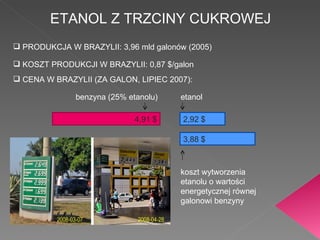
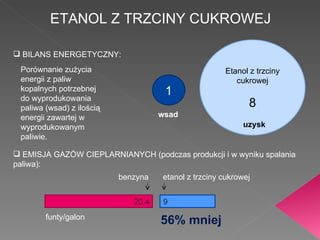

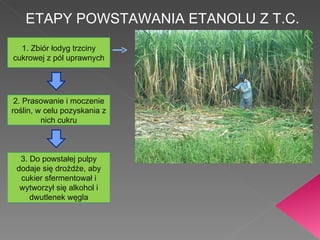
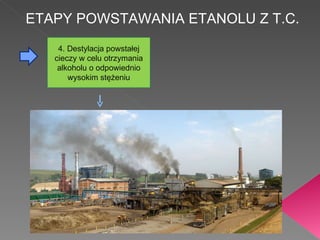
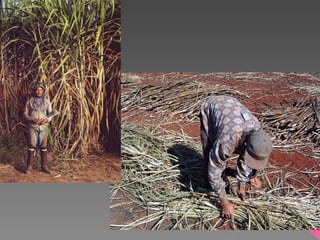

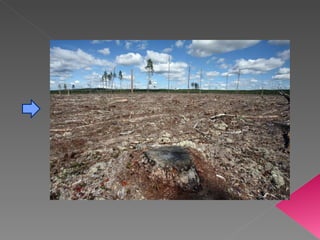

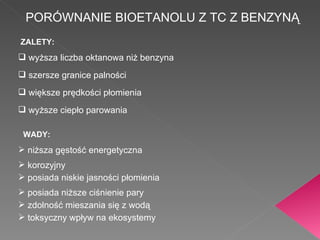
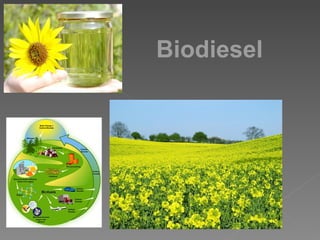

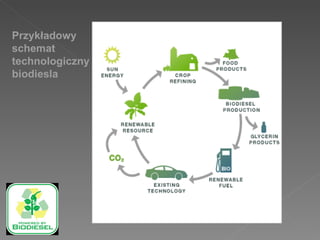
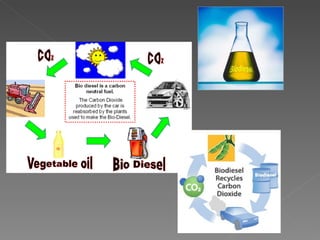


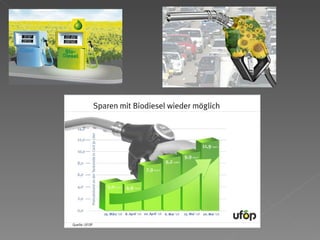
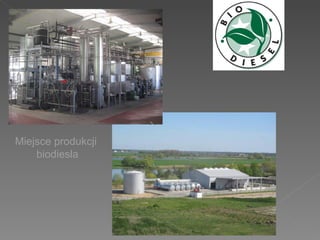




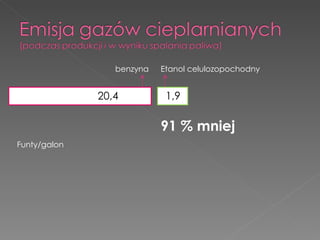
Ad
Recommended
Bioetanol aneta sulecka
Bioetanol aneta suleckaLiga Ochrony Przyrody Oddział Szczecin
╠²
Kamapania Biokomponenty a ŚrodowiskoBiodiesel and Vegetable oils
Biodiesel and Vegetable oilsLizbeth Patatuchi
╠²
The document discusses biodiesel's production from vegetable oils and animal fats, highlighting its benefits in reducing pollutants compared to traditional diesel. It also addresses challenges such as engine compatibility and operational limitations, particularly in diesel engines. Additionally, it notes the economic aspects and potential of biodiesel in Mexico, mentioning both opportunities and market barriers.Biogas as Vehicle Fuel
Biogas as Vehicle FuelThe Climate Trust
╠²
The document discusses biogas as a renewable vehicle fuel and its role in reducing greenhouse gas emissions through various projects financed by The Climate Trust. It highlights the environmental benefits of biogas, which is generated from organic waste, producing renewable energy and avoiding methane emissions. Specific examples of biogas projects are provided, illustrating their significant climate benefits compared to other renewable energy sources.Combustion of solid biofuel
Combustion of solid biofuelH Janardan Prabhu
╠²
The document discusses solid biofuels and their role in energy production, particularly in rural areas, emphasizing biomass's potential to reduce dependence on fossil fuels. It covers the characteristics, preparation, and applications of biofuels, while also addressing the advantages and disadvantages of using solid biofuels compared to coal. Additionally, various combustion processes and technologies for biomass energy generation are detailed, along with the challenges associated with transport and efficiency.Renewable energy(Biogas)
Renewable energy(Biogas)Balaka Prashanth
╠²
Biogas is a renewable energy source produced from the anaerobic breakdown of organic matter, primarily composed of methane and carbon dioxide. It can be utilized for heating, electricity generation, and as a vehicle fuel, offering benefits like reduced pollution and potential job creation. However, challenges such as impurities, limited technological advancements, and economic viability for large-scale production remain to be addressed.Carbon trading 19 41_45
Carbon trading 19 41_45domsr
╠²
- The Kyoto Protocol established a carbon credit trading mechanism where countries can meet emission reduction targets by purchasing certified emission reduction (CER) credits from emission reduction projects in developing countries under the Clean Development Mechanism (CDM).
- India has high potential for carbon credits due to a wide range of possible CDM project types and sizes, technical expertise, and a transparent CDM approval process. However, carbon credit prices are determined by policy issues, market fundamentals, and technical analysis.
- India is a party to the UNFCCC and has established a National CDM Authority to oversee CDM projects. CDM projects in India span sectors like energy, manufacturing, and waste management, with the energy sector representing most10 - Industrial Ecology.pdf
10 - Industrial Ecology.pdfMiracle680542
╠²
Industrial ecology aims to mimic natural ecosystems by creating closed-loop industrial systems where wastes from one process serve as inputs for another. An ideal industrial ecosystem would have renewable energy sources, completely recycle all materials with no waste outputs, and consist of diverse interconnected industries. The key components are primary materials producers, energy sources, manufacturing sectors, waste processing sectors, and consumers. The goals are to maximize resource and energy efficiency while minimizing environmental impacts.Biodiesel
BiodieselGhassan Hadi
╠²
This document discusses biodiesel, its history and production process. It begins by defining biodiesel as a fuel made from oils and fats that can be used directly in diesel engines or blended with diesel. It then discusses biodiesel's origins in Rudolf Diesel's intent for his engine to run on peanut oil. The document outlines the transesterification process used to produce biodiesel from triglycerides and methanol. It notes the challenges of sourcing feedstocks and developing technologies to handle multiple feedstock types for biodiesel production.Pradeep Tharakan - Cambodia's National Solar Park
Pradeep Tharakan - Cambodia's National Solar ParkOECD Environment
╠²
The Cambodia National Solar Park project, supported by ADB, has achieved the lowest solar energy tariff in the ASEAN region at USC 3.877/kWh, attracting significant interest from both local and international bidders. The project encompasses the development of a solar park facility and associated solar PV plants, with a focus on scaling renewable energy capacity in Cambodia. ADB's comprehensive program includes support throughout the tender process, financial closure, and aims to catalyze green finance for renewable projects across ASEAN.Energy Economics
Energy Economicsmaggiewinslow
╠²
This document summarizes key topics in electricity pricing and environmental economics:
- The levelized cost of electricity (LCOE) is the price required to equate the net present value of revenue from electricity production with the net present value of production costs over the lifetime of a generating asset. LCOE is important for policy decisions but difficult to estimate due to uncertainties.
- Externalities like environmental costs are not included in LCOE but should be through "shadow pricing" to properly evaluate generation options.
- Subsidies have been used to promote renewable energy but a better approach may be taxing "brown" or polluting power to reflect externalities rather than just making "green" power artificiallyBiogas final project proposal submitted
Biogas final project proposal submittedAdane Nega
╠²
This document proposes a research project to implement a low-cost technology for biogas generation from kitchen wastes in Ethiopia. It notes that over 85% of Ethiopians rely on biomass like firewood for energy, causing deforestation, health issues from indoor air pollution, and burdening women's time. As alternatives, fuel-efficient stoves only delay problems, while biogas from wastes can provide renewable energy. The proposed project would develop plastic tank digesters using kitchen waste for biogas, addressing costs of existing programs. It aims to provide a sustainable and affordable energy source while supporting Ethiopia's initiatives and the university's social goals.Biofuels Issues, Trends and Challenges
Biofuels Issues, Trends and ChallengesGerard B. Hawkins
╠²
The document discusses the opportunities and challenges in developing sustainable biofuels, particularly ethanol and biodiesel, highlighting their increasing integration into U.S. gasoline consumption. It details market trends, regulatory issues, production challenges, and the evolution of biofuels technology, including insights on cellulosic biofuels and legislative impacts on production. The analysis underscores the ongoing developments in biofuel infrastructure and production methods, emphasizing a shift towards more advanced biofuel technologies.Production of mixed alcohol fuels from Biomass
Production of mixed alcohol fuels from BiomassAwais Chaudhary
╠²
The document discusses the potential of mixed alcohol production from biomass in Pakistan as a renewable energy source to address environmental issues and energy shortages. It outlines the biomass resources, processes involved in producing mixed alcohol fuels, and the benefits such as increased farmer profits, reduced emissions, and energy security. The paper emphasizes the need for research and development to enhance the mixed alcohol production industry in Pakistan.Biofuels
BiofuelsRajalaxmy Raji
╠²
Biofuel is a liquid fuel produced from plant or animal material and used as an alternative to petroleum-based fuels. There are several types of biofuels including biodiesel, bioalcohols like ethanol, and biogas. Biofuels can be produced from feedstocks like palm, coconut, jatropha seeds, rapeseed, and algae. They are produced through fermentation of sugar crops or by heating plant oils. Biofuels are a renewable source and their production can benefit rural development.Biomass Pyrolysis
Biomass PyrolysisAvishek Rauniyar
╠²
Biomass pyrolysis produces bio-oil, syngas, and biochar. It involves heating biomass like wood or agricultural waste in the absence of oxygen. Fast pyrolysis at 450-1000┬░C yields 60% bio-oil that can be upgraded to fuels or chemicals. Syngas and biochar are also produced. Biochar improves soil quality and stores carbon long-term. The document discusses pyrolysis process parameters, products, applications, and provides an example of its environmental and energy benefits compared to fossil fuels according to a life cycle analysis. Bottlenecks to commercializing biomass energy in India include supply chain and policy issues.Biofuels
BiofuelsFahim Tahmid
╠²
Biofuels are fuels produced from biological sources such as agricultural waste, sugarcane, corn, and algae. They include bioethanol, biodiesel, and biogas. Biofuels offer advantages like reducing dependence on fossil fuels, lowering greenhouse gas emissions, and reducing foreign oil reliance. However, they also have disadvantages like potentially higher food prices and shortages if too much cropland is used for fuel production rather than food. Common biofuels include bioethanol from sugar cane or corn fermentation, biodiesel from vegetable or animal fats, and biogas from organic waste digestion.Biomass
BiomassPakistan Ordnance Factories
╠²
1. Biomass refers to organic material from plants and includes plant matter, animal waste, and organic industrial and municipal wastes.
2. Major sources of biomass include woody biomass from forests, herbaceous biomass like grasses and energy crops, aquatic plants and algae, agricultural residues, animal waste, sewage, municipal solid waste, and industrial waste.
3. Pakistan has significant biomass resources including agricultural residues, animal manure, municipal solid waste, and sugarcane waste that can be used for biogas and electricity generation.Biomass Energy
Biomass EnergyTom McLean
╠²
Biomass is a renewable energy source from living or dead organisms that can be used as an alternative to fossil fuels. It has advantages such as creating more jobs, reducing dependency on imported oil, and being environmentally friendly compared to fossil fuels. However, it also has disadvantages like requiring large amounts of farmland and contributing to greenhouse gas emissions. While biomass is currently cheaper than fossil fuels, producing and collecting it can be expensive. Energy forecasts predict that biomass will generate a significant portion of the U.S.'s renewable energy in the coming years, remaining the second largest source behind hydropower.Biodiesel 101-presentation
Biodiesel 101-presentationAkash Mandal
╠²
This document provides an overview of biodiesel for dealers and drivers. It defines biodiesel as a renewable fuel made from vegetable oils or animal fats that meets ASTM specifications. The document discusses biodiesel's status as an advanced biofuel under the Renewable Fuel Standard, its lower emissions and high energy balance compared to petroleum diesel. It also outlines top reasons why customers use biodiesel, including sustainability, energy security, and health benefits.Biomass basics
Biomass basicsDurga Prasada Rao M
╠²
The document discusses biomass energy in India. It provides details on:
1) The states leading in biomass power capacity are Uttar Pradesh, Maharashtra, Karnataka, Andhra Pradesh, Tamil Nadu, and Chhattisgarh. Total biomass power capacity in India was over 4,700 MW as of 2015-16.
2) Biomass power comes from combustion, gasification, and bagasse cogeneration. Off-grid biomass power comes from cogeneration, gasifiers, and waste-to-energy. Total biomass-based power capacity in India was nearly 6,000 MW.
3) Major barriers to faster development of biomass powerBio mass Energy
Bio mass EnergySeminar Links
╠²
Biomass is a renewable energy source derived from living organisms, primarily used for electricity generation and heat production, with its contribution to global energy supply growing steadily. It has the potential to supply nearly 50% of the world's total energy demand sustainably, while facing challenges such as land availability and market organization. Despite its advantages in reducing fossil fuel dependence and greenhouse gases, barriers like inadequate information and rising costs hinder the realization of biomass energy's full potential.Biodiesel
BiodieselAglaia Connect
╠²
Biodiesel is an alternative fuel made from vegetable oils or animal fats that can be used in diesel engines. It has benefits over petroleum diesel such as being non-toxic, biodegradable, and producing lower emissions. However, biodiesel also faces challenges including limited availability of feedstock for large-scale replacement of petroleum diesel, issues with cold weather operation, and potential engine and emissions optimization. While biodiesel provides short and long-term environmental benefits, issues around fuel stability, transportation costs, and lack of understanding of its full environmental impacts need to be addressed for it to become a primary fuel source.Bio Fuels
Bio FuelsSrinivasvasu1998
╠²
Biofuels are liquid fuels made from plant materials, crops, and waste vegetable oils. They have several advantages including reducing greenhouse gas emissions, increasing energy security, and promoting renewable energy. Biofuels can be produced from energy crops or byproducts and include bioethanol and biodiesel. Biodiesel is biodegradable and non-toxic while bioethanol is produced through fermentation. Both biofuels burn cleaner than conventional fuels and reduce greenhouse gas emissions. Biodiesel performs nearly the same as conventional diesel but may solidify in cold environments.Biomass Power Plants
Biomass Power PlantsDaniel Campos
╠²
The document discusses biomass power plants and using wood as an energy source. It addresses the strategic, environmental, social, and economic issues. Specifically, it discusses how using wood as an energy source can provide energy independence and stability. It also describes how biomass power reduces greenhouse gas emissions and pollution compared to fossil fuels. The document then discusses biomass cogeneration systems that produce both electricity and heat. It provides diagrams of biomass power plant systems including storage and grate designs.Biodiesel
BiodieselKhawar Nehal khawar.nehal@atrc.net.pk
╠²
The document discusses biodiesel, including what it is, how it is made through transesterification, its properties, benefits over petroleum diesel such as lower emissions and biodegradability, common blend ratios, applications in vehicles such as buses and trains as well as potential in aircraft, and examples of biodiesel use in Pakistan including plans to blend it with diesel. Historical background of biodiesel and research opportunities are also mentioned.DR KILADEJO ADEKEMI.S MD COURSE WORK CARBON CREDIT MARKET 09012023.pptx
DR KILADEJO ADEKEMI.S MD COURSE WORK CARBON CREDIT MARKET 09012023.pptxAdekemiKiladejo
╠²
Carbon credits are instruments that represent one ton of carbon dioxide or greenhouse gas emissions removed from the atmosphere. This document outlines the carbon credit market, including the types (compliance and voluntary), segments (clean development mechanism, joint implementation, emissions trading, voluntary market), and how carbon credits work by allowing companies to purchase credits from those that have reduced emissions. The benefits of carbon credits and regulations around them in Nigeria are also discussed, as well as the qualifications, purchasers, and roadmap for implementing a carbon credit system in Nigeria through the new African Carbon Market Initiative.Petroleum processing
Petroleum processingmadan lal
╠²
The document provides a comprehensive overview of petroleum processing, detailing various refining processes including physical separation, catalytic conversion, and thermal processes. Key methods such as distillation, catalytic cracking, and coking are discussed, highlighting their objectives and operational steps involved in transforming crude oil into valuable products like gasoline, diesel, and lubricants. It emphasizes the importance of desalting and the role of different catalysts and techniques employed to enhance efficiency and product quality in refineries.Produkcja biodiesla agnieszka gawska
Produkcja biodiesla agnieszka gawskaLiga Ochrony Przyrody Oddział Szczecin
╠²
Kamapania Biokomponenty a ŚrodowiskoProdukcja bioetanolu wyka lukasz
Produkcja bioetanolu wyka lukaszLiga Ochrony Przyrody Oddział Szczecin
╠²
Kamapania Biokomponenty a ŚrodowiskoMore Related Content
What's hot (20)
Biodiesel
BiodieselGhassan Hadi
╠²
This document discusses biodiesel, its history and production process. It begins by defining biodiesel as a fuel made from oils and fats that can be used directly in diesel engines or blended with diesel. It then discusses biodiesel's origins in Rudolf Diesel's intent for his engine to run on peanut oil. The document outlines the transesterification process used to produce biodiesel from triglycerides and methanol. It notes the challenges of sourcing feedstocks and developing technologies to handle multiple feedstock types for biodiesel production.Pradeep Tharakan - Cambodia's National Solar Park
Pradeep Tharakan - Cambodia's National Solar ParkOECD Environment
╠²
The Cambodia National Solar Park project, supported by ADB, has achieved the lowest solar energy tariff in the ASEAN region at USC 3.877/kWh, attracting significant interest from both local and international bidders. The project encompasses the development of a solar park facility and associated solar PV plants, with a focus on scaling renewable energy capacity in Cambodia. ADB's comprehensive program includes support throughout the tender process, financial closure, and aims to catalyze green finance for renewable projects across ASEAN.Energy Economics
Energy Economicsmaggiewinslow
╠²
This document summarizes key topics in electricity pricing and environmental economics:
- The levelized cost of electricity (LCOE) is the price required to equate the net present value of revenue from electricity production with the net present value of production costs over the lifetime of a generating asset. LCOE is important for policy decisions but difficult to estimate due to uncertainties.
- Externalities like environmental costs are not included in LCOE but should be through "shadow pricing" to properly evaluate generation options.
- Subsidies have been used to promote renewable energy but a better approach may be taxing "brown" or polluting power to reflect externalities rather than just making "green" power artificiallyBiogas final project proposal submitted
Biogas final project proposal submittedAdane Nega
╠²
This document proposes a research project to implement a low-cost technology for biogas generation from kitchen wastes in Ethiopia. It notes that over 85% of Ethiopians rely on biomass like firewood for energy, causing deforestation, health issues from indoor air pollution, and burdening women's time. As alternatives, fuel-efficient stoves only delay problems, while biogas from wastes can provide renewable energy. The proposed project would develop plastic tank digesters using kitchen waste for biogas, addressing costs of existing programs. It aims to provide a sustainable and affordable energy source while supporting Ethiopia's initiatives and the university's social goals.Biofuels Issues, Trends and Challenges
Biofuels Issues, Trends and ChallengesGerard B. Hawkins
╠²
The document discusses the opportunities and challenges in developing sustainable biofuels, particularly ethanol and biodiesel, highlighting their increasing integration into U.S. gasoline consumption. It details market trends, regulatory issues, production challenges, and the evolution of biofuels technology, including insights on cellulosic biofuels and legislative impacts on production. The analysis underscores the ongoing developments in biofuel infrastructure and production methods, emphasizing a shift towards more advanced biofuel technologies.Production of mixed alcohol fuels from Biomass
Production of mixed alcohol fuels from BiomassAwais Chaudhary
╠²
The document discusses the potential of mixed alcohol production from biomass in Pakistan as a renewable energy source to address environmental issues and energy shortages. It outlines the biomass resources, processes involved in producing mixed alcohol fuels, and the benefits such as increased farmer profits, reduced emissions, and energy security. The paper emphasizes the need for research and development to enhance the mixed alcohol production industry in Pakistan.Biofuels
BiofuelsRajalaxmy Raji
╠²
Biofuel is a liquid fuel produced from plant or animal material and used as an alternative to petroleum-based fuels. There are several types of biofuels including biodiesel, bioalcohols like ethanol, and biogas. Biofuels can be produced from feedstocks like palm, coconut, jatropha seeds, rapeseed, and algae. They are produced through fermentation of sugar crops or by heating plant oils. Biofuels are a renewable source and their production can benefit rural development.Biomass Pyrolysis
Biomass PyrolysisAvishek Rauniyar
╠²
Biomass pyrolysis produces bio-oil, syngas, and biochar. It involves heating biomass like wood or agricultural waste in the absence of oxygen. Fast pyrolysis at 450-1000┬░C yields 60% bio-oil that can be upgraded to fuels or chemicals. Syngas and biochar are also produced. Biochar improves soil quality and stores carbon long-term. The document discusses pyrolysis process parameters, products, applications, and provides an example of its environmental and energy benefits compared to fossil fuels according to a life cycle analysis. Bottlenecks to commercializing biomass energy in India include supply chain and policy issues.Biofuels
BiofuelsFahim Tahmid
╠²
Biofuels are fuels produced from biological sources such as agricultural waste, sugarcane, corn, and algae. They include bioethanol, biodiesel, and biogas. Biofuels offer advantages like reducing dependence on fossil fuels, lowering greenhouse gas emissions, and reducing foreign oil reliance. However, they also have disadvantages like potentially higher food prices and shortages if too much cropland is used for fuel production rather than food. Common biofuels include bioethanol from sugar cane or corn fermentation, biodiesel from vegetable or animal fats, and biogas from organic waste digestion.Biomass
BiomassPakistan Ordnance Factories
╠²
1. Biomass refers to organic material from plants and includes plant matter, animal waste, and organic industrial and municipal wastes.
2. Major sources of biomass include woody biomass from forests, herbaceous biomass like grasses and energy crops, aquatic plants and algae, agricultural residues, animal waste, sewage, municipal solid waste, and industrial waste.
3. Pakistan has significant biomass resources including agricultural residues, animal manure, municipal solid waste, and sugarcane waste that can be used for biogas and electricity generation.Biomass Energy
Biomass EnergyTom McLean
╠²
Biomass is a renewable energy source from living or dead organisms that can be used as an alternative to fossil fuels. It has advantages such as creating more jobs, reducing dependency on imported oil, and being environmentally friendly compared to fossil fuels. However, it also has disadvantages like requiring large amounts of farmland and contributing to greenhouse gas emissions. While biomass is currently cheaper than fossil fuels, producing and collecting it can be expensive. Energy forecasts predict that biomass will generate a significant portion of the U.S.'s renewable energy in the coming years, remaining the second largest source behind hydropower.Biodiesel 101-presentation
Biodiesel 101-presentationAkash Mandal
╠²
This document provides an overview of biodiesel for dealers and drivers. It defines biodiesel as a renewable fuel made from vegetable oils or animal fats that meets ASTM specifications. The document discusses biodiesel's status as an advanced biofuel under the Renewable Fuel Standard, its lower emissions and high energy balance compared to petroleum diesel. It also outlines top reasons why customers use biodiesel, including sustainability, energy security, and health benefits.Biomass basics
Biomass basicsDurga Prasada Rao M
╠²
The document discusses biomass energy in India. It provides details on:
1) The states leading in biomass power capacity are Uttar Pradesh, Maharashtra, Karnataka, Andhra Pradesh, Tamil Nadu, and Chhattisgarh. Total biomass power capacity in India was over 4,700 MW as of 2015-16.
2) Biomass power comes from combustion, gasification, and bagasse cogeneration. Off-grid biomass power comes from cogeneration, gasifiers, and waste-to-energy. Total biomass-based power capacity in India was nearly 6,000 MW.
3) Major barriers to faster development of biomass powerBio mass Energy
Bio mass EnergySeminar Links
╠²
Biomass is a renewable energy source derived from living organisms, primarily used for electricity generation and heat production, with its contribution to global energy supply growing steadily. It has the potential to supply nearly 50% of the world's total energy demand sustainably, while facing challenges such as land availability and market organization. Despite its advantages in reducing fossil fuel dependence and greenhouse gases, barriers like inadequate information and rising costs hinder the realization of biomass energy's full potential.Biodiesel
BiodieselAglaia Connect
╠²
Biodiesel is an alternative fuel made from vegetable oils or animal fats that can be used in diesel engines. It has benefits over petroleum diesel such as being non-toxic, biodegradable, and producing lower emissions. However, biodiesel also faces challenges including limited availability of feedstock for large-scale replacement of petroleum diesel, issues with cold weather operation, and potential engine and emissions optimization. While biodiesel provides short and long-term environmental benefits, issues around fuel stability, transportation costs, and lack of understanding of its full environmental impacts need to be addressed for it to become a primary fuel source.Bio Fuels
Bio FuelsSrinivasvasu1998
╠²
Biofuels are liquid fuels made from plant materials, crops, and waste vegetable oils. They have several advantages including reducing greenhouse gas emissions, increasing energy security, and promoting renewable energy. Biofuels can be produced from energy crops or byproducts and include bioethanol and biodiesel. Biodiesel is biodegradable and non-toxic while bioethanol is produced through fermentation. Both biofuels burn cleaner than conventional fuels and reduce greenhouse gas emissions. Biodiesel performs nearly the same as conventional diesel but may solidify in cold environments.Biomass Power Plants
Biomass Power PlantsDaniel Campos
╠²
The document discusses biomass power plants and using wood as an energy source. It addresses the strategic, environmental, social, and economic issues. Specifically, it discusses how using wood as an energy source can provide energy independence and stability. It also describes how biomass power reduces greenhouse gas emissions and pollution compared to fossil fuels. The document then discusses biomass cogeneration systems that produce both electricity and heat. It provides diagrams of biomass power plant systems including storage and grate designs.Biodiesel
BiodieselKhawar Nehal khawar.nehal@atrc.net.pk
╠²
The document discusses biodiesel, including what it is, how it is made through transesterification, its properties, benefits over petroleum diesel such as lower emissions and biodegradability, common blend ratios, applications in vehicles such as buses and trains as well as potential in aircraft, and examples of biodiesel use in Pakistan including plans to blend it with diesel. Historical background of biodiesel and research opportunities are also mentioned.DR KILADEJO ADEKEMI.S MD COURSE WORK CARBON CREDIT MARKET 09012023.pptx
DR KILADEJO ADEKEMI.S MD COURSE WORK CARBON CREDIT MARKET 09012023.pptxAdekemiKiladejo
╠²
Carbon credits are instruments that represent one ton of carbon dioxide or greenhouse gas emissions removed from the atmosphere. This document outlines the carbon credit market, including the types (compliance and voluntary), segments (clean development mechanism, joint implementation, emissions trading, voluntary market), and how carbon credits work by allowing companies to purchase credits from those that have reduced emissions. The benefits of carbon credits and regulations around them in Nigeria are also discussed, as well as the qualifications, purchasers, and roadmap for implementing a carbon credit system in Nigeria through the new African Carbon Market Initiative.Petroleum processing
Petroleum processingmadan lal
╠²
The document provides a comprehensive overview of petroleum processing, detailing various refining processes including physical separation, catalytic conversion, and thermal processes. Key methods such as distillation, catalytic cracking, and coking are discussed, highlighting their objectives and operational steps involved in transforming crude oil into valuable products like gasoline, diesel, and lubricants. It emphasizes the importance of desalting and the role of different catalysts and techniques employed to enhance efficiency and product quality in refineries.Viewers also liked (6)
Produkcja biodiesla agnieszka gawska
Produkcja biodiesla agnieszka gawskaLiga Ochrony Przyrody Oddział Szczecin
╠²
Kamapania Biokomponenty a ŚrodowiskoProdukcja bioetanolu wyka lukasz
Produkcja bioetanolu wyka lukaszLiga Ochrony Przyrody Oddział Szczecin
╠²
Kamapania Biokomponenty a ┼ÜrodowiskoRo┼øliny bioenergetyczne uprawiane w Polsce
Ro┼øliny bioenergetyczne uprawiane w Polsce Maria Pirecka
╠²
Ro┼øliny bioenergetyczne uprawiane w Polsce _biomasaBiofuel-Powerpoint-main
Biofuel-Powerpoint-mainMischka Alli
╠²
This document discusses different types of biofuels and whether they are an environmental solution or problem. It outlines three main types of biofuels: first generation from starch/sugar/vegetable oil which are not sustainable; second generation from non-food crops; and third generation from algae. While biofuels can be used as fuel substitutes and help reduce global warming, first generation biofuels could damage food supplies if used in large quantities. The document also notes biofuels' advantages like being renewable and sourced from waste, but disadvantages include high costs and overuse of fertilizers in crop production.BIOBUTANOL- AN ADVANCED BIOFUEL
BIOBUTANOL- AN ADVANCED BIOFUELAnjana S Nair
╠²
The document discusses biobutanol as an advanced biofuel, highlighting its production methods, advantages, and challenges. It covers various aspects, including the genetic engineering of strains, substrates for production, and bioreactor types. Despite its benefits, such as higher energy density and compatibility with existing fuel infrastructure, biobutanol production faces hurdles like low output concentration and product inhibition.Biomass As A Renewable Energy Source:
The case of Converting Municipal Solid...
Biomass As A Renewable Energy Source:
The case of Converting Municipal Solid...IEEE UKM Student Beanch
╠²
The document discusses the role of biomass as a renewable energy source, focusing on converting municipal solid waste to energy and exploring its advantages and disadvantages. It outlines various biomass processing methods, biofuel production options, and the environmental implications associated with biomass usage. Additionally, it highlights the significance of biomass resources in Malaysia, particularly within the context of the palm oil industry.Biomass As A Renewable Energy Source:
The case of Converting Municipal Solid...
Biomass As A Renewable Energy Source:
The case of Converting Municipal Solid...IEEE UKM Student Beanch
╠²
Ad
More from Nequit (20)
Ad
Biopaliwa prezentacja
- 1. Biopaliwa
- 2. ╠²
- 3. ╠²
- 4. ╠²
- 5. W ostatnich latach zauwa┼╝alny jest dynamiczny wzrost produkcji biopaliw na ┼øwiecie.
- 6. Prawie ca┼éy etanol w USA wytwarzany jest z ┼╝├│┼étej kukurydzy paszowej. Gorzelnie ju┼╝ walcz─ģ o surowiec z hodowcami byd┼éa, podnosz─ģc cen─Ö ziarna. Wi─Ökszo┼ø─ć etanolu jest jako dodatek do benzyny.
- 7. Produkcja kukurydzy: W USA: 4,86 MLN GALEON├ōW (2006) Cena detaliczna w USA (za galeon, lipiec 2007) Koszt produkcji kukurydzy: W USA: 1,09 $/galon 2,62 $ 3,71 $ 3,03 $ Etanol (E-85) Koszt wytworzenia etanolu o warto┼øci energetycznej r├│wnej galonowi benzyny Benzyna
- 8. Por├│wnanie zu┼╝ycia energii z paliw kopalnych potrzebnej do wyprodukowania paliwa (wsad) z ilo┼øci─ģ energii zawartej w wyprodukowanym paliwie: Etanol z kukurydzy 1,3 1 WSAD UZYSK
- 9. 20,4 16,2 benzyna Etanol z kukurydzy 22 % mniej Funty/galon
- 10. ETANOL Z TRZCINY CUKROWEJ
- 11. ETANOL Z TRZCINY CUKROWEJ Trzcina cukrowa daje od 5700 do 7600 litr├│w etanolu z hektara, dwa razy wi─Öcej ni┼╝ kukurydza. ┼üodyga to w 20% cukier, kt├│ry poddawany jest fermentacji w celu uzyskania alkoholu. Spalanie trzcinowych odpad├│w mo┼╝e by─ć ┼║r├│d┼éem energii dla gorzelni. G┼ü├ōWNY PRODUCENT: Brazylia
- 12. ETANOL Z TRZCINY CUKROWEJ PRODUKCJA W BRAZYLII: 3,96 mld galon├│w (2005) KOSZT PRODUKCJI W BRAZYLII: 0,87 $/galon CENA W BRAZYLII (ZA GALON, LIPIEC 2007): 4,91 $ 2,92 $ 3,88 $ koszt wytworzenia etanolu o warto┼øci energetycznej r├│wnej galonowi benzyny benzyna (25% etanolu) etanol
- 13. ETANOL Z TRZCINY CUKROWEJ BILANS ENERGETYCZNY: Por├│wnanie zu┼╝ycia energii z paliw kopalnych potrzebnej do wyprodukowania paliwa (wsad) z ilo┼øci─ģ energii zawartej w wyprodukowanym paliwie. 1 Etanol z trzciny cukrowej 8 wsad uzysk EMISJA GAZ├ōW CIEPLARNIANYCH (podczas produkcji i w wyniku spalania paliwa): 20,4 9 funty/galon 56% mniej etanol z trzciny cukrowej benzyna
- 14. ╠²
- 15. ETAPY POWSTAWANIA ETANOLU Z T.C. 1. Zbi├│r ┼éodyg trzciny cukrowej z p├│l uprawnych 2. Prasowanie i moczenie ro┼ølin, w celu pozyskania z nich cukru 3. Do powsta┼éej pulpy dodaje si─Ö dro┼╝d┼╝e, aby cukier sfermentowa┼é i wytworzy┼é si─Ö alkohol i dwutlenek w─Ögla
- 16. ETAPY POWSTAWANIA ETANOLU Z T.C. 4. Destylacja powstałej cieczy w celu otrzymania alkoholu o odpowiednio wysokim stężeniu
- 17. ╠²
- 18. ╠²
- 19. ╠²
- 20. ╠²
- 21. POR├ōWNANIE BIOETANOLU Z TC Z BENZYN─ä wy┼╝sza liczba oktanowa ni┼╝ benzyna szersze granice palno┼øci wi─Öksze pr─Ödko┼øci p┼éomienia wy┼╝sze ciep┼éo parowania ZALETY: ni┼╝sza g─Östo┼ø─ć energetyczna korozyjny posiada niskie jasno┼øci p┼éomienia posiada ni┼╝sze ci┼ønienie pary zdolno┼ø─ć mieszania si─Ö z wod─ģ WADY: toksyczny wp┼éyw na ekosystemy
- 22. Biodiesel
- 24. Przykładowy schemat technologiczny biodiesla
- 25. ╠²
- 26. ╠²
- 27. Biodiesel- zdolno┼ø─ć produkcyjna w Niemczech lata 2000-2009 (w tonach)
- 28. ╠²
- 29. Miejsce produkcji biodiesla
- 30. ╠²
- 31. Trawy takie jak proso r├│zgowate (z prawej), rosn─ģce na ziemiach niezdatnych do uprawy innych ro┼ølin, mog┼éyby zast─ģpi─ć do 13% zu┼╝ywanej na ┼øwiecie ropy ŌĆō je┼øli uda si─Ö wynale┼║─ć metod─Ö ich przer├│bki na etanol.
- 32. Odpady pochodzenia rolniczego (np. sloma, li┼øcie i plewy) Odpady z przemys┼éu drzewnego, jak ┼øcinki i trociny oraz kora Zestalone odpady miejskie (┼ømieci z gospodarstw domowych i makulatura) ┼Ücier drzewny Szybko rosn─ģce gatunki traw preriowych, kt├│rych uprawa wymaga zu┼╝ycia mniejszej ilo┼øci energii.
- 33. Por├│wnanie zu┼╝ycia energii z paliw kopalnych potrzebnej do wyprodukowania paliwa (wsad) z ilo┼øci─ģ energii zawartej w wyprodukowanym paliwie. 1 2 Etanol celulozopochodny Mi─Ödzy 2 a 36 zale┼╝nie od sposobu wytwarzania 36
- 34. 20,4 1,9 benzyna Etanol celulozopochodny 91 % mniej Funty/galon